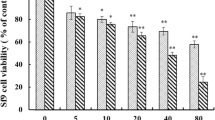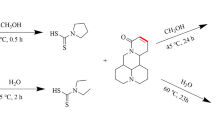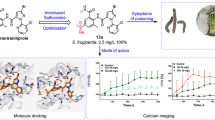Abstract
In recent years, concerns over the potential impact of synthetic pesticides on the environment have promoted the research and development of environmentally friendly “green” pesticides. In the current study, we utilized a green biomimetic insecticide, 1,5-bis-(5-nitro-2-furanyl)-1,4-pentadien-3-one (compound C), to examine its cytotoxicity on an insect cell line, Drosophila melanogaster (SL2). Results from MTT assay showed cells treated with 100 µM of compound C for 48 h significantly inhibited the growth of SL2 cells by 87.71±0.96%. We subsequently attempted to illustrate the act on mechanism of compound C at the cellular level and found that it initiated apoptosis through a mitochondrial-dependent mechanism that increased the activity of caspase-3 and altered the cell cycle. These results suggest that the green biomimetic insecticide, compound C, is a novel and potent inducer of insect cell apoptosis.
Similar content being viewed by others
References
Gavrilescu, M. Fate of pesticides in the environment and its bioremediation. Eng Life Sci 5:497–526 (2005).
Crouse, G. D. Pesticide leads from nature. Chem Tech 28:36–45 (1998).
Liu, C. L. & Li, Z. M. Agrochemicals discovered and developed from natural leads-fungicides. Pesticides 42:1–4 (2003).
Gao, P., Hou, T. P., Gao, R., Cui, Q. & Liu, S. G. Ac-tivity of the botanical aphicides 1,5-diphenyl-1-penta-none and 1,5-diphenyl-2-penten-1-one on two species of aphididnae. Pest Manag Sci 57:307–310 (2001).
Hou, T. P., Cui, Q., Xiang, R. L., Hou, R. T. & Liu, S. G. Study on extraction isolation of killing aphid compo-nents from Stellera chamaejasme L.. J Sichuan Univ: Natural Science Edition 38:743–747 (2001).
Hou, T. P., Cui, Q., Chen, S. H., Hou, R. T. & Liu, S. G. New compounds against aphids from Stellera chamae-jasme L.. Chin J Org Chem 22:67–70 (2002).
Cui, Z. N., Zhang, L. H., Ling, J. & Yang, Y. Synthesis, insecticidal activity and 3D-QSAR studies on diacylhy-drazine derivatives containing furan. Chin J Org Chem 10:1482–1491 (2010).
Cao, M. et al. Synthesis and biological activities of perfluoroisopropyl-substituted furanacyl thiourea com-pounds. Agrochemicals 51:488–490 (2012).
Hu, Y. G. et al. Synthesis and antitumor activity of some 2-Amino-furo(2,3-d)-yrimidin-4(3H)-one deriva-tives. Chin J Org Chem 32:1468–1472 (2012).
Chen, L., Wang, X. L., Lu, T. & Hou, T. P. Lead opti-mization and insecticidal activity of analogues of da-phneolone isolated from Stellera chamaejasme L.. Pest Manag Sci 63:928–934 (2007).
Lu, T., Chen, L. & Hou, T. P. Synthesis and structure-ac-tivity study of botanical aphicides 1,5-diphenyl-1-pen-tanone analogues. Pestic Biochem Physiol 89:60–64 (2007).
Jin, H. Structural optimization and bioactivities of daph-neone analogues. in: Sichuan Univ, Ph.D. (2009).
Kumarswamy, R., Seth, R. K., Dwarakanath, B. S. & Chandna, S. Mitochondrial regulation of insect cell apoptosis: evidence for permeability transition pore-in-dependent cytochrome-c release in the Lepidopteran Sf9 cells. Int J Biochem Cell 41:1430–1440 (2009).
Scarlett, J. L. et al. Changes in mitochondrial mem-brane potential during stauros porine-induced apopto-sis in jurkat cells. FEBS Lett 475:267–272 (2000).
Salehzadeh, A. et al. The effects of phytochemical pes-ticides on the growth of cultured invertebrate and verte-brate cells. Pest Manag Sci 58:268–276 (2002).
William, G. & Rocktown, N. J. 2,2-dimethyl-2,3-dihy-drobenzofuranyl-7-n-methylcarbamate, US 3474171 A (1969).
Motohiro, T., Shinzo, K., Ikuya, O., Kathleen, A. D. & John, E. C. Potency and selectivity of trifluoroacetylim-ino and pyrazinoylimino nicotinic insecticides and their fit at a unique binding site niche. J Med Chem 51:4213–4218 (2008).
Chen, L. et al. Synthesis and biological activity of tong-haosu analogs containing phenoxy-phenyl moiety. Chin J Chem 22:984–989 (2004).
Lorraine, M. Studying stress: the importance of organ-ism-level responses. Ecol Appl 9:431–440 (1999).
Smagghe, G., Goodman, C. L. & Stanley, D. Insect cell culture and applications to research and pest manage-ment. In Vitro Cell Dev Biol-Animal 45:93–105 (2009).
Francesca, F., Fiorenza, M. & Giuseppina, M. Cytotox-icity induced by nivalenol, deoxyivaleol, and fumonisin B1 in the SF-9 insect cell line. In Vitro Cell Dev Bi-ol-Animal 40:166–171 (2004).
Zhang, X. G., Tao, K. & Hou, T. P. Investigation of 1-(4-morpholinophenyl)-3-(4-fluorophenyl)-propenone and 1-(4-morpholinophenyl)-3-(3-fluorophenyl)-pro-penone as new apoptosis inducers on Spodoptera frugiperda (Sf9) cells. Toxicol Mech Methods 22:315–320 (2012).
Murray, A. W. Revisiting the cell cycle: cyclins revisit-ed. Cell 116:221–234 (2004).
Mossman, T. Rapid colorimetric assay for cellular growth and survival: application to proliferation and cy-totoxicity assays. J Immunol Methods 65:55–63 (1983).
Wang, J., Li, X. R., Liu, Y. B. & Zhao, X. Salt stress induces programmed cell death in Thellungiella halophila suspension-cultured cells. J Plant Physiol 167:1145–1151 (2010).
Author information
Authors and Affiliations
Corresponding author
Rights and permissions
About this article
Cite this article
Ren, YH., Jin, H., Tao, K. et al. Apoptotic effects of 1,5-bis-(5-nitro-2-furanyl)-1, K]4-pentadien-3-one on Drosophila SL2 cells. Mol. Cell. Toxicol. 11, 187–192 (2015). https://doi.org/10.1007/s13273-015-0017-3
Received:
Accepted:
Published:
Issue Date:
DOI: https://doi.org/10.1007/s13273-015-0017-3




